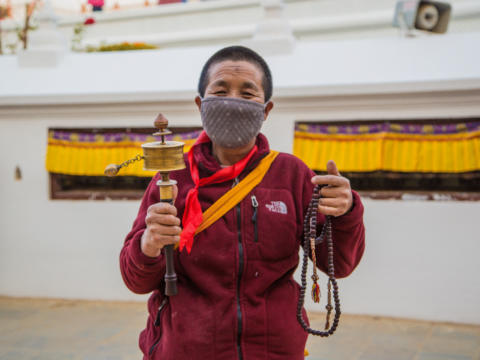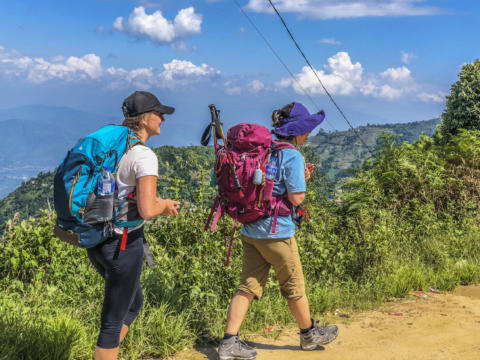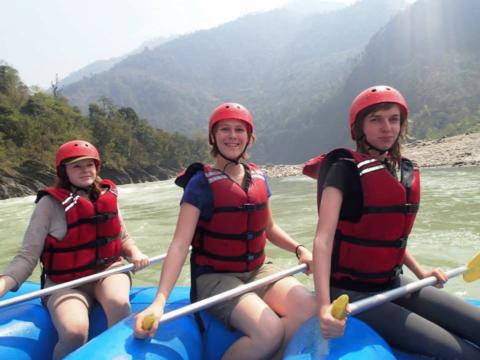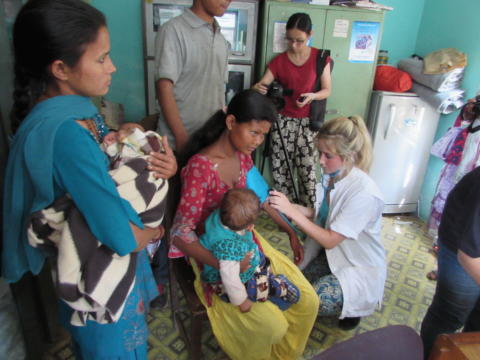Only 720€ per week!
Everest Base Camp Trek
Everest - Nepal
Set your foot at the base of Everest! This action-packed program will get your hiking shoes dirty through rough treks and immersion into Nepalese culture.
The trek goes through Namche and Tengboche, Dingboche and Lobuche then heads towards Mt. Everest Base Camp. Exciting suspension bridges hanging over raging rivers and long uphill hiking will let you know you are approaching the highest mountain in the world.
Program Description
Our program will get you introduced to Nepalese culture while reaching the base camp of the mighty Mount Everest. You will encounter the highland Sherpa people’s lifestyle and their unique cultural hospitality and get to see ice fall views from Kala Patthar, visit local places such as Namche Bazar, Tengboche Monastery, Khumjung and so much more! Everest Base Camp Trek is a mountain adventure journey to the roof of the world!
First Week: Introduction Week
Our introduction week will get you kickstarted into this amazing country located at the foothills of the mighty Himalayas. Not only will you get to learn about the language and lifestyle, but you will also visit temples, go on a hiking tour and even take part in a scavenger hunt race at a local market!
Second and Third Week: Everest Base Camp Trek
The Everest Trekking region is known as the most popular destination among high alpine travelers and to make it to the base is on every adventurer-at-heart’s bucket list. Our trek will rarely allow you to rest but in exchange, you will pass through Sherpa villages, admire some of the world’s most stunning landscapes and get to see the best of Nepalese culture.
Fourth Week: Community Service
You will get the chance to give back to Nepal by helping out in some of our projects. Your choices will be teaching at a local school, helping out at a kindergarten or aiding injured dogs in our shelter.
What is included in the program
- Airport transfers as per the policy – Airport Pickup in Kathmandu – Tribhuvan International Airport
- Presence of a dedicated program coordinator throughout your travel, at the projects and facilities – Logistical management support in case of emergencies
- Authentic Nepali meals and European (breakfast, lunch, dinner) for the duration of the entire program as per the meal plan
- Accommodation at hotels, tea houses, and at our accommodation facility – shared accommodation
- Local transportation to all venues
- Entry fees to all places
- Extensive pre-departure information
- Overland public local transportation
What is excluded in the program
- Personal expenses such as table drinks, room service items, laundry, telephone calls, tips, porterage at hotels or airport, bottles of water during your road travel etc.
- Any additional expenses caused by or liability for the disturbance in the program due to circumstances, weather conditions, sickness, natural disasters, riots etc.
- Liability for or insurance against injury, loss of life, accidents or loss of goods.
- Our program does not cover any liability and does not insure participants. Participants must have appropriate insurance before joining the program.
- Any camera fee where applicable.
- Any service not specified above.
Few things to consider when you are with us!
- Returning to the accommodation after your personal trips before 22.00 hrs every day
- You will not be allowed to hire any vehicle on your own
- Consumption of alcohol inside the accommodation is strictly prohibited
- Respect and adhere to our code of conduct
- Our staff is there to support you, guide you and make your trip memorable. We kindly request you to follow their instructions at all times
- You will not be allowed to bring outsiders inside our centers/tea houses or hotels
Aims & Objectives
The aim of this program is to bring you closer to authentic Nepal. This trek brings you closer to the majestic Himalayas and truly immerse you in the Nepalese culture, customs and lifestyle.
Schedule
Week 1: Introduction in Kathmandu
Day 1: Monday
- Puja to the gods and goddess and name-giving ceremony
- Go over the week’s schedule and handing over of documents
- Introduction game to get to know fellow participants
- Cultural seminar on social behavioral norms, dos and don’ts in Nepalese culture. Cross-cultural orientation on eating and drinking habits, bathing, clothing and toilet etiquette in Nepalese culture.
- Go out to explore your surrounding around the program house
Day 2: Tuesday
- Nepali language training
- Talk on general health precautions and safety during the program
- Cultural as well as historical orientation tour to Swoyambhunath temple.
- Shopping at the local market
Day 3: Wednesday
- Yoga and meditation session
- Nepali language training
- Lecture on religion and culture
- A cultural as well as historical orientation tour to the famous Kirtipur (an ancient settlement of indigenous group of Kathmandu)
Day 4: Thursday
- Nepali language training
- Nepali cooking session
- An amazing race for a Scavenger Hunt at the local market and orientation tour to an exclusive area of Kathmandu and tourist downtown.
Day 5: Friday
- It’s all about hiking today! We will go on a nature trail into the mountains to get a view of Kathmandu valley.
- Feedback sharing, evaluation
Day 6: Saturday
- Free time to explore on your own or relax
Day 7: Sunday
- Free time to explore on your own or relax
Week 2: Everest Base Camp Trek
Day 8: Monday
Fly from Kathmandu to Lukla which is at an elevation of 2700m and trek to Phakding (3 – 4 hrs) and overnight. A spectacular flight and a jagged landing on a steep mountain runway will bring us to the start of our trek to the village of Lukla.
Day 9: Tuesday
Phakding trek to Namche Bazaar 3440m, (6 – 7 hrs) and overnight. We will continue north following the Dudh Kosi river and on to Jorsale, where we will enter the Sagarmatha (Everest) National Park. From here, it will be a short walk to the confluence of two rivers, the lmja Drangpa (Imja Khola) and the Nangpo Tsangpo (Bhote Kosi) followed by a steep climb (for about 2 hrs) to Namche Bazaar, the main town in the Khumbu region. Namche is a prosperous Sherpa town and an important trading center with a weekly Saturday market.
Day 10: Wednesday
Namche Bazaar (resting day and overnight). Namche Bazaar is tucked away between two ridges amongst the giant peaks of the Khumbu. Once named the “Trekkers Mecca of Nepal”. Namche now boasts an abundance of lodges and souvenir shops. It is an ideal place to spend a resting day, acclimatizing to the new altitude of 3450m before heading off towards Gokyo.
Options for acclimatization walks include a visit to Khunde Hospital and also the one hour walk up to the Everest Hotel above Namche for the sunset view of Ama Dablam, Nuptse, Lhotse and Everest.
Day 11: Thursday
Namche Bazaar trek to Tengboche (3860m) for about 6 hrs and overnight. From Namche, the trail contours around the side of the valley, high above the Dudh Kosi. Now, we will get our first really good views of the great peaks of the Khumbu including Mt Everest, Lhotse, Nuptse and Ama Dablam. Passing by several villages and numerous tea shops, we will descend steeply to a bridge over the river at Phunki Tenga. The village is an excellent lunch spot, and here we can rest before making the steep climb to Tengboche.
Although tiring, the hike up the zigzag path has numerous distractions, with rhododendron bushes, beautiful birds and superb mountain scenery. Tengboche is famous for its legendary monastery, the largest in the Khumbu.
We will stay near the monastery with Everest, Lhotse and Ama Dablam framed in the doorway of our tea house.
Day 12: Friday
Tengboche trek to Pheriche, (4252m) for 6 hours and overnight. After breakfast, we will head up to Pheriche with the majestic Amadablam overshadowing our day. On the way, we will meet a little Sherpa village called Pangboche and continue to Pheriche.
Day 13: Saturday
Pheriche trek to Lobuche (4930m) for six hours and overnight. We will continue up the wide valley beneath the impressive peaks of Cholatse and Taboche on the left. We will then turn right and climb more steeply towards the foot of the Khumbu Glacier. At the top of this climb, there are many stone cairns, built as memorials to the many Sherpas who have died while climbing Mt Everest. The path then climbs gently along the glacier, to eventually reach the cluster of houses at Lobuche.
Day 14: Sunday
Lobuche trek to Gorakshep (5184m) for two and half hours and (Kalapattar 5500m) and back to Labuche.
Week 3
Day 15: Monday
Lobuche trek to Dingboche (6 and half hrs) and overnight. It is downhill most of the way, as we will retrace our steps to Dughla and descend to Pheriche. The Himalayan Rescue Association have their trekkers aid post here and it is quite interesting to visit.
Day 16: Tuesday
Dingboche trek to Tengboche (3860m, for 4 hrs) and overnight. We will continue to follow the river and after crossing it, climb back up through birch and rhododendron forest to Tengboche.
Day 17: Wednesday
Tengboche trek to Namche Bazaar (3440m) for 5 hrs and overnight. From Tengboche, we will descend to the bridge over the Dudh Kosi at Phunki, where there are water driven prayer wheels. Then, we will climb and contour around the hillside to Namche.
Day 18: Thursday
Namche Bazaar trek to Lukla (2840m) for 7 hours and overnight. From Namche Bazaar, the trail descends steeply to the village of Jorsale. Passing the villages of Phakding (2640m) and Choplung, we will reach Chaurikharka and the trail that cuts up to the airstrip at Lukla.
Day 19: Friday
Lukla to Kathmandu. Early morning flight to Kathmandu
Day 20: Saturday
Free days to relax and to catch your breath.
Day 21: Sunday
Free days to relax and to catch your breath.
Week 4: Community Work in Kathmandu
Day 22-26: Monday to Friday
You can choose from the following options:
- Teaching at local schools
- Helping out at a Kindergarten
- Working with rescued dogs at our Canine Rehabilitation project
Note: This schedule can be changed and/or amended depending on weather conditions, local conditions and unforeseen circumstances.
Participant Criteria & Requirements
Standard Requirements
Minimum age: 18
Maximum age: 65
Minimum English level: Basic
CRB required: On Signup
Passport copy required: On Signup
Resume copy required: No
Required qualification: None
Additional Requirements
Due to the length and active nature of this program, a decent level of fitness is required.
Air ticket from Kathmandu to Lukla and Lukla to Kathmandu should be purchased by the participant on his/her own.
Additional Equipment
We recommend following equipment and items to pack for your trekking trip.
For head
- Sun Hat / baseball cap
- Fleece/Wool hat (to cover ears) for winter
- Sunglasses & reading glasses
- Scarf to cover face (dust/wind)
For lower Body
- Under garments
- Hiking shorts – 1
- Lightweight walking pants – 1
- Light weight thermal leggings – winter
- Fleece or tracksuit pants
For Feet
- Thin cotton inner socks
- Thick warm wool hiking socks
- Hiking boots
- Sandals
- Walking poles
For Upper Body
- T-shirts
- Lightweight thermal tops – winter
- Fleece long shelve tops
- Down vest/jacket – winter
- Poncho rain cover
For Hands
- Lightweight fleece gloves – winter
- Playing card
- Trail map & guide book
For Sleeping
- Sleeping bag
- Sleeping bag liner
- Pillow slip/case
Medical Kit
- See your Doctor for complete medical kit Including Dimox – for high elevation
Accessories
- Headlamp & spare batteries
- Dry packs
- Open neck water bottles
- Watch with light & alarm
- Pack cover
- Day pack
- Money belt
- Toiletries & Personal Hygiene
- 1x quick dry towel & face cloth
- Shampoo & Conditioner
- Toothbrush & paste (biodegradable)
- Multipurpose wipes (face & body)
- Deodorant
- Face & Body moisturizer
- Nail clippers/file
- Small comb/brush
- Clothes washing soap (biodegradable)
- Toilet paper (you can buy more on trek)
- Anti-Bacterial wipes (4x packs)
- Hand sanitizer (small bottle)
- Sun block face/body high UV protection
- Lip block with UV protection
- Feminine hygiene products
Extra Items
- Camera & extra batteries
- Binoculars
- Reading books
- Journal & pen
- Energy/protein bars
- Walkman & Steripen
***Make sure to pack no heavier than 15kg after fully packed.***
Location
This route takes you through Dingboche, Lobuche, Gorakshep and the towards the Everest base camp.
About the Accommodation
Along the trekking route you will have overnight stays in hotels/tea houses. More information can be found inside the schedule.
Food Arrangements
Mostly Nepalese style dishes (vegetarian and chicken) will be served during the trip.
Facilities
Along the route – but not at all times – there are ATMs and small local stores. Please make sure you have enough money with you before starting the trip.
Activities & Events
No scheduled activities outside the program.
Sights & Surroundings
You’ll be on a busy schedule.
Transportation
From this location we do not provide free transport to other locations.
Quick Facts
Name: Federal Democratic Republic of Nepal
Population: 28.98 million
Capital: Kathmandu
Language: Nepali
Currency: Nepalese rupee (NPR)
Time zone: UTC +5:45
Country Information
Namaste and welcome to Nepal, a country of high Himalayan Mountains, artistic monuments, exotic wildlife, and diverse cultures. Located between 80 12' east longitude and between 26 22' and 30 27' north latitude, Nepal extends along the south slopes of the Himalayas in central Asia.
Although Nepal is small, it has the greatest latitudinal variation of any country. The land rises from the southern plains of the Terai, barely above sea level at 70 meters, to the top of the Mt. Everest, the highest peak on Earth at 8848 meters above sea level, in a distance of less than 200 km.
Climate
Weather conditions in Nepal vary from region to region. Summer and late spring temperatures range from about 28C in the hill region of the country to more than 40C in the Terai. In the winter, the average maximum and minimum temperatures in the Terai range from a brisk 7C to mild 23C. The central valleys experience a minimum temperature often falling below the freezing point and a chilly 12C maximum. Much colder temperatures prevail at higher elevations. The Kathmandu Valley has a mild climate, ranging from 19 to 27C in the summer and 2 to 20C in the winter. In the winter, it only snows in the high elevations, around 9,000 feet. In the highest elevations, it snows year-round. The monsoon can last from mid-June to mid-August although the majority of the rain arrives in July.
Winter: From December to February, the mornings and evenings will be cold; in the daytime, you will be fine with a sweater or thin jacket.
Spring: From March to May is the best time to be in Nepal as it is neither hot nor cold. However, it does get quite windy.
Summer: June to August. Hot, humid and monsoon season.
Fall: Very pleasant and mild weather. It gets a bit windy but you will be fine with a sweater or a jacket.
Culture
Nepal's many ethnic groups are as varied as its land with their own languages and cultures. A wide variety of ethnic groups occupy the mid-hills. In the Kathmandu Valley the major population that we find is Newars, whose culture and artistry have earned them an international reputation. The Sherpas are known as tough mountain climbers. Brahmins and Chhetris are scattered over the hills and valleys, and Tamangs are found in the districts around the Kathmandu Valley. The Rais, Limbu, Gurung, Magars of the mid-hills have earned fame as Gurkha soldiers. Lowland ethnic groups such as Maithili, Bhojpuri, and Tharu enhance the colorful mosaic. The population of Nepal is about 28.98 million.
Transportation
Local Bus
One of the cheapest ways to get around Nepal. However, you get what you pay for! They are often crowded (and not just with people, sometimes even goats!). Most buses don’t depart until they get filled up, so it is not a good idea for those who have a tight schedule.
Tourist Bus
These are slightly more expensive than local buses but also more comfortable. Greenline buses offer routers between Kathmandu, Chitwan, Lumbini and Pokhara. It is recommended to book in advance to make sure you get a seat.
Taxis
Taxis are either private taxis as in any other cities or “10 Rupee” taxis, which are public. This means they don’t leave a place until they are full. The name, “10 Rupee taxis” does not mean they cost 10 Rupee! Do feel free to bargain





